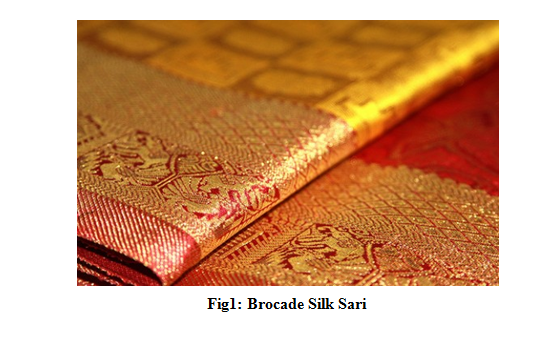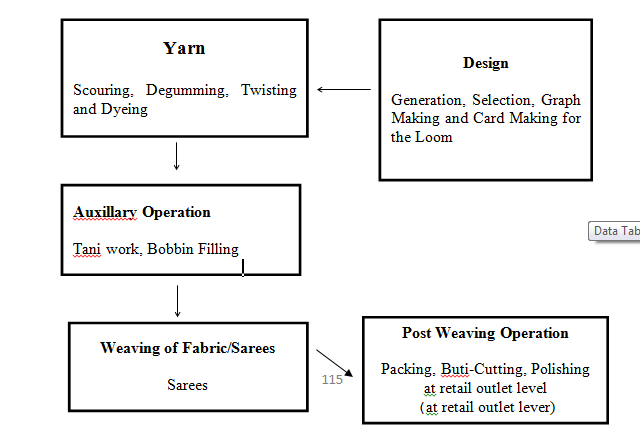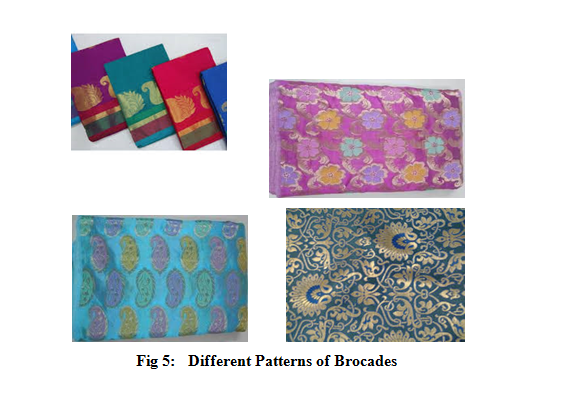Alleviation: An International Journal of Nutrition, Gender & Social Development, ISSN 2348-9340
Volume 3, Number 3 (2016) : 32-36
©Arya PG College, Panipat & Business Press India Publication, Delhi
www.aryapgcollege.com, www.apcjournals.com
A Study on Journey of Brocades
Mrs. Sandeep Reen
Assistant Professor, Guru Nanak Girls College, Yamunanagar
(Haryana), India
Email: sandeepreen18@gmail.com
Introduction
Banaras (Varanasi), a holy city of Uttar Pardesh is a center for brocade and hand-made textiles and sarees since ancient times. The word “Brocade” is taken from the Latin word “Brochus” denoting to transfix. Kin-khab or Kim-khab are the names of the Banaras brocade which means as cloth of gold. Silk was added later to give color and body to the textile. New gold or silver wires are used as a special weft twisted along with silk. Designs are worked out in gold or silver in the Banaras brocades and sarees.

Historical Background
Because of the demand for expensive fabrics by the royal families or temples, the brocade weaving centers of India developed in and around the capitals of kingdoms or holy cities. The ancient centers were situated in Banaras, Gujarat, Delhi, Agra and Murshidabad.
Over the centuries, brocades from Banaras have created their own special place. The city of Banaras itself has a unique place in Indian history and culture. As far back as 4th century B.C., it was a rich, flourishing city and was renowned worldwide for its textile industry. The “Hiranya” cloth mentioned in the Rig-Veda has been interpreted as the earliest equivalent for the kin-khabs. According to Buddhist literature, Varanasi fabrics were beautiful to look at and wear, pleasant to handle, more popular with rich and tasteful people all over the world. In the Buddhist legends and texts, there are many references to Kasi. As per the legends, when Buddha attained Mahaparinirvana, his mortal remains were wrapped in a Banaras fabric radiating with rays of yellow, red and blue. All these references support that brocade art was, in all probability in existence since very early times in Banaras.
The silk weaving industry in Varanasi had for centuries been divided between the Hindus and Muslim. The Hindus monopolized trade while the weavers were mostly Muslims.
Raw Material
Brocade weaving is an age old tradition in India especially with gold and silver. There are two main types of Brocades:
Silk Brocades
The basic raw material for many types of brocades is mainly mulberry silk threads. Silk threads are categorized according to their structure, texture, characteristics and laid-down regulations. Chinya is silk thread with a twist, also known as spun silk and is used in making kimkhab- a heavy brocades.
Zari Brocades
In India, gold and silver thread is used in zari brocades. These were produced mainly in Surat and Varanasi. Kalabattu, the gold and silver thread is not a wire of gold but a specially prepared thread of silk with metallic mounting of silver and gold.

Fabric Types
Fabric types can be categorized into two: Loom finished and Yardage. Loom finished fabrics are sarees, odhani, patkas, pankhas, curtains etc. Yardage is usually for dress material upholstery and curtains. The best known brocade fabrics were Kimkhwab or Kinkhab.
Kinkhab can be of following types:
1) Cloth with pure silver or gold.
2) Brocade with gold or silver thread with interwoven colored silks here and there to emphasize the design.
3) Bafta is mostly of closed woven color silk, with only selected parts of the design in gold or silver thread.
4) Silk and muslins brocades with very little metallic thread, or with golden borders and pieces sewn on them.
Production Process
For weaving sarees, brocades and other products, the weavers of Banaras generally use old pit loom. Wooden loom of its own patterns having elaborate and crowded arrangements of cotton strings from top to bottom are generally used by the weavers.
The following important steps are generally followed for weaving Banaras sarees/brocade, which takes minimum 6 days, depending upon the designs:
Procurement of Raw Materials
Selection and acquisition of the selected raw materials and to make it fit for use is the most important first step. It begins with the selection of the silk yarn, which is of various qualities and imported from various production centers.
Twisting of the Silk Yarn
Sometimes, the silk yarns are twisted on itself without undergoing the further process. It is called singles. When two or more than two yarns are twisted in an opposite direction, it is called thrown singles. The process of twisting silk yarns at this stage is called silk throwing.
Preparatory Activities
This process requires greater experience and judgment and quick eyes in the ruler for reeling and checking of uniformity in thickness and roundness of the hanks of the threads for further operation.
Natawa: It is bamboo frame with a central axis. The thread from the reel is transferred to natawa.
Pareta: It is made up of a central bar of bamboo. Around its upper end is a framework of bamboo sticks, supported by spokes slopping upwards, assembling together and forming a cone.
Khali: It is also a cylindrical framework of bamboos with a different pattern.
Tagh: Here silk is given a slight twist.
Warp thread: These are twisted before being shifted from pareta to the spindle of the charkha so arranged that on its way to the spindle, the thread receive a sufficient amount of twist.
Chemical treatments, bleaching and dyeing: The yarn after being duly processed in respect of throwing, coupling, twisting undergoes further treatment. The silk thread in its native state has a gum like substance (Sericin) of a yellowish color in its composition. This sericin is taken out for bringing softness and shininess to the yarn as also to enable penetration of the coloring matter on the dye in the yarn in the process of its dyeing. Therefore, this gum-like material (Sericin) is removed by boiling the silk in soap water of certain strength and for certain duration.
Making the warp: The warp or taana machine is used to prepare the warp by rolling the threads on a wooden log in a particular sequence of colors depending on the design.
Kalabattun: The next essential material in order of importance is the Kalabattun, the silver or gold thread.
Naksha or the design: The designer first works out the design of a fabric, destined to be reproduced on paper. This work is called Likhai. Nakshaband draws up designs to order. This nakshaband himself is well acquainted with all the technicalities and manipulations of weaving and rendering of a given design or pattern into a woven fabric. He has to foresee his artistic and technical aspects of reproduction and their affect and to prescribe proper method and direction for it. This he does by means of cotton threads in the form of graph work.
Weaving Activity
The Banaras weaving shed which contains a loom for weaving a khimkhab is known as a Karkhana. This is generally a small chamber and usually not well lighted. The process of weaving simple silk fabrics and the tools employed therein are not generally very different from the process and tools used in weaving other fabrics but the Banaras kimkhab and other golden and silver thread fabrics, with a heavy body of silk, are woven with an indigenous device, quite special to Banaras.

Fig 4: Thematic Presentation of the Production Process
Completion and Finishing of the Fabric
The weaving thus continues and the fabric is patiently and carefully completed. The completion of the fabric is called Reja Pujna.
Finishing
Formerly, special workers (Called Kundigar) used to do the pressing and finishing. They used to wash the fabric in a specially made bath, then dried it, pressed, glazed and folded for delivery. But now the pressing is done by the machine rollers and otherwise. This finishing process is called ‘Polishing’.
Famous Varieties of Brocades
Alfi
It is pattern zari brocade used as dress material.
Tashi
It is type of kinkhab in which an extra warp of gold badla zari is used to create a pattern with an extra weft of silver badlazari or vice-versa.
Pot Than or Bafta
In this, the silk background is patterned with silk pattern or zari.
Tissue
A thin transparent light-weight material used mainly for turbans, veils, dupattas and saris.
Kora Silk
The weft and warp of this material is made of pure raw silk with designs made with extra cotton weft. It is used as dress material and sarees.
Himru or Amru
The pattern is made using silk thread on silk.
Mashru
It is a fabric with a woven striped or zig-zag pattern.
Patterns
Nature is the main source of design making, with the floral forms called Butis or Butas. There are basic patterns which are shaped into several forms such as Badam (Almond) Buti, Kairi (Mango) buti, Chaand (Moon) buti, Asharfi (Coin) buti, Paan (Beetle Leaf) buti and Pankha (Fan) buti. Another celebrated pattern of Banaras brocade is Jaal or Net Design, also known as Jangala. The Banaras Jaal is a very delicate. In the jaal; flower, bird or animal forms were enclosed within a net-worked form evolved with arch, square or other geometrical forms.
Religion is also basis for variety of decorative motifs. Varanasi being a religious center has a large demand for cloth woven specially for temples and devotees. Garments such as caps and Safas or angochas has religious mantras woven into them.
Importance of Colors in Brocades
Colours play an important part in weaving brocade. The beauty of the brocade depends upon colour synchronization. Red is the colour of Love, Yellow is the colour of Basant (spring) or young blossoms, Nila is the colour of Lord Krishna (Who is linked to a rain filled cloud) and Gerua (Saffron) is the colour of the earth.

Earlier vegetable dyes were used during weaving. These produced fast colour, lasted for almost a generation and remained as beautiful and vivid as ever. Now-a-days, chemical dyes have gained popularity as they are cheaper, less time-consuming, produce a large variety of colour and can be manufactured on large scale. Some of the names used in Banaras, for various colours in which fabrics were produced are:
1) Kasni- Mixed colour of blue, red and yellow.
2) Zard- Yellow.
3) Gandhaki- Sulphus-Yellow.
4) Kapasi- Pale-Yellow.
5) Basanti- Primrose.
6) Motia-Yellowish-Red.
7) Kavlai- Deep Orange.
8) Sultani Surkh- Scarlet.
9) Gulabi- Pink.
10) Asmani- Sky Blue.
11) Firozai- Turqoise Blue.
12) Lajwanti- Turqoise Blue.
13) Baijni- Violet.
14) Uda- Purple-Blue.
15) Kahi- Dark Green.
16) Khaki- Grey.
17) Kafuri- Straw-Coloured.
18) Badami- Light-Buff
Conclusions
Brocades have been traditional rich textiles of our country since centuries and are still the heart of all different varieties of traditional textiles in India as well as abroad. Today till date, Brocades are earning great market in and outside India. The charm of having brocade as one of the wardrobe collection is considered a mark of dignity and sophistication for females of HIG society. This beautiful art is still being encouraged and in demand of different markets of different countries.
References
Chhatopadhyay K (1985) Handicrafts of India. New Delhi: Indian Council for Cultural Relations.
Gillow J and Bryan (1999) World Textiles. New York: Bulfinch Press Book.
Kapur C and Jain R (2000) Hand Crafted Indian Textiles. New Delhi: Roli Books.
Das S (1992) Fabric Art. NewDelhi: Abhinav Publications.
Thames and Hudson (1991) Textile Designs. London: Thames and Hudson.
Sarma VS (1998) Studies in Indian Textiles. New Delhi: Bhartiya Kala Prakashan.

